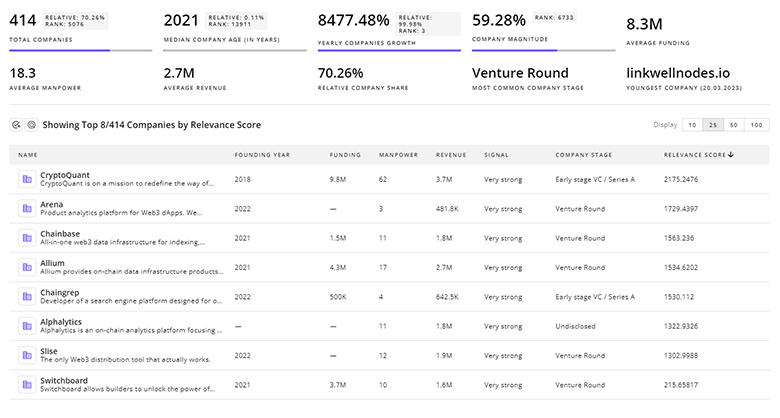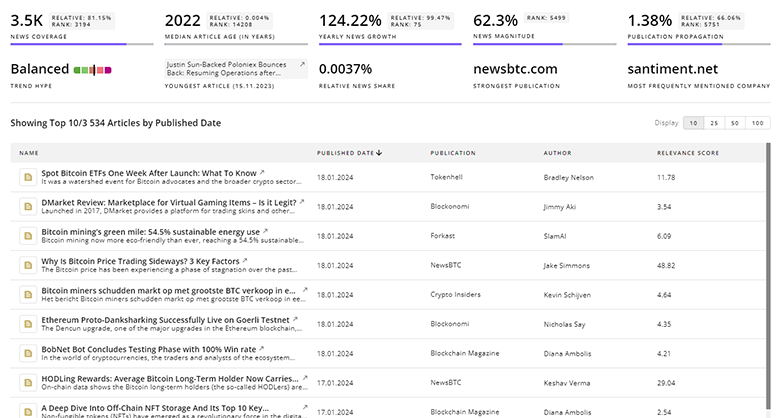
Food Waste Management Report
: Analysis on the Market, Trends, and TechnologiesThe food waste management sector is at a pivotal juncture, with total funding raised by companies in this field reaching USD 12.74 billion and annual revenue of USD 23.31 billion, underscoring significant investor confidence and commercial scale in a “Developing” maturity category. This growth is propelled by a need to divert the 59.84 percent of wasted food still sent to landfills, a dominant disposal route that emits methane at 80 times the global-warming potential of CO₂ (US EPA). Advanced on-site processing systems, heightened regulatory mandates, and rising corporate ESG commitments are converging to reshape the industry around integrated, data-driven solutions that convert waste into energy, feed, and soil amendments with clear economic returns.
This article was last updated 128 days ago. If you find any info is missing, let us know!
Topic Dominance Index of Food Waste Management
The Dominance Index of Food Waste Management looks at the evolution of the sector through a combination of multiple data sources. We analyze the distribution of news articles that mention Food Waste Management, the timeline of newly founded companies working in this sector, and the share of voice within the global search data
Key Activities and Applications
- Waste Processing and Separation: Mechanical systems crush, grind, and separate organic fractions from contaminants, preparing feedstock for biological or thermal treatment.
- Fermentation and Biological Decomposition: Both anaerobic digestion for biogas production and aerobic fermentation to yield fertilizers or animal feed are core to converting organics into value.
- Resource Recovery and Byproduct Generation: Technologies extract high-value outputs—organic compost, protein-rich animal feed, and biodiesel precursors—from food waste streams.
- Integrated System Design: End-to-end platforms unite collection, pretreatment, digestion/composting, and byproduct recovery in a single solution for institutional or community scale.
- Deodorization and Pollution Control: Specialized filters and chemical treatments mitigate odors and manage leachate, addressing a key barrier to urban and on-site deployment.
Emergent Trends and Core Insights
- Persistent Landfill Dominance: 39.6 million tons (59.84 percent) of U.S. food waste went to landfills in 2019, highlighting ample opportunity for diversion technologies (US EPA).
- Shift Toward Value-Added Products: An increasing share of innovations focus on transforming waste into animal feed, fertilizers, and biofuels, moving beyond disposal to resource valorization.
- Efficiency and Scalability Focus: Rapid fermentation processes and modular on-site systems are reducing treatment times and enabling adoption by restaurants and institutions.
- Multi-Technology Integration: Combining anaerobic digestion with aerobic composting, enzymatic pretreatment, and mechanical separation within unified systems boosts overall throughput and flexibility.
- Byproduct Quality and Safety Emphasis: Precise control of microbial cultures, sterilization steps, and impurity removal ensure regulatory compliance for fertilizers and feed derived from waste.
Technologies and Methodologies
- Anaerobic Digestion: Sealed reactors use microbial consortia to convert organics into biogas and digestate, a core waste-to-energy pathway.
- Aerobic Digestion/Composting: Oxygen-driven breakdown produces stable compost; on-site units enable rapid processing at point of generation.
- Enzymatic Degradation: Enzyme additives accelerate decomposition, increasing yield and reducing residence times.
- Insect Larvae Bioconversion: Black Soldier Fly larvae transform organic waste into protein-rich biomass for feed and nutrient-rich frass for soil amendment.
- Mechanical Preprocessing: Crushing, grinding, and solid–liquid separation condition waste slurry for downstream treatment.
- Thermal Dehydration and Pyrolysis: High-temperature processes reduce moisture, kill pathogens, and, at extreme conditions, produce biochar and syngas.
- Integrated Platforms: Systems integrating collection sensors, IoT-enabled monitoring, and automated controls drive smart operations and data-driven optimization across the entire waste lifecycle.
Food Waste Management Funding
A total of 431 Food Waste Management companies have received funding.
Overall, Food Waste Management companies have raised $10.7B.
Companies within the Food Waste Management domain have secured capital from 1.7K funding rounds.
The chart shows the funding trendline of Food Waste Management companies over the last 5 years
Food Waste Management Companies
- The Waste Transformers: Offers containerized anaerobic digesters that convert food waste into biogas for on-site energy and natural fertilizer, reducing transport costs and supporting facility-level decarbonization.
- Food Recycle: Australian startup with patented technology to transform commercial food waste into high-performance animal feeds and liquid fertilizers, targeting international licensing.
- BioGreen360: U.S. company deploying a closed-loop “Food Cycling” Platform that processes 100 percent of food waste into sterile fertilizer without water, with a focus on carbon and water footprint reduction.
- Limetrack: UK-based digital B2B platform combining SMART bins and analytics for regulatory compliance, cost savings, and net-zero goals in corporate and municipal food waste management.
Uncover actionable market insights on 2.1K companies driving Food Waste Management with TrendFeedr's Companies tool.

2.1K Food Waste Management Companies
Discover Food Waste Management Companies, their Funding, Manpower, Revenues, Stages, and much more
Food Waste Management Investors
Get ahead with your investment strategy with insights into 1.6K Food Waste Management investors. TrendFeedr’s investors tool is your go-to source for comprehensive analysis of investment activities and financial trends. The tool is tailored for navigating the investment world, offering insights for successful market positioning and partnerships within Food Waste Management.

1.6K Food Waste Management Investors
Discover Food Waste Management Investors, Funding Rounds, Invested Amounts, and Funding Growth
Food Waste Management News
TrendFeedr’s News feature offers access to 3.1K news articles on Food Waste Management. The tool provides up-to-date news on trends, technologies, and companies, enabling effective trend and sentiment tracking.

3.1K Food Waste Management News Articles
Discover Latest Food Waste Management Articles, News Magnitude, Publication Propagation, Yearly Growth, and Strongest Publications
Executive Summary
Food waste management is rapidly transforming from basic disposal to a sophisticated ecosystem of integrated technologies, driven by regulatory mandates, sustainability goals, and clear economic incentives. Core methodologies—anaerobic/aerobic digestion, enzymatic and insect bioconversion, and thermal dehydration—are converging within unified systems enhanced by IoT and data analytics. The market’s maturation is marked by significant funding, rising revenues, and strategic expansion of platform-based offerings capable of covering the full waste lifecycle. For stakeholders, the imperative is to adopt interoperable, adaptable solutions that maximize resource recovery, meet ESG benchmarks, and capture value from what was once considered refuse.
Have expertise in trends or technology? Your input can enrich our content — consider collaborating with us!











